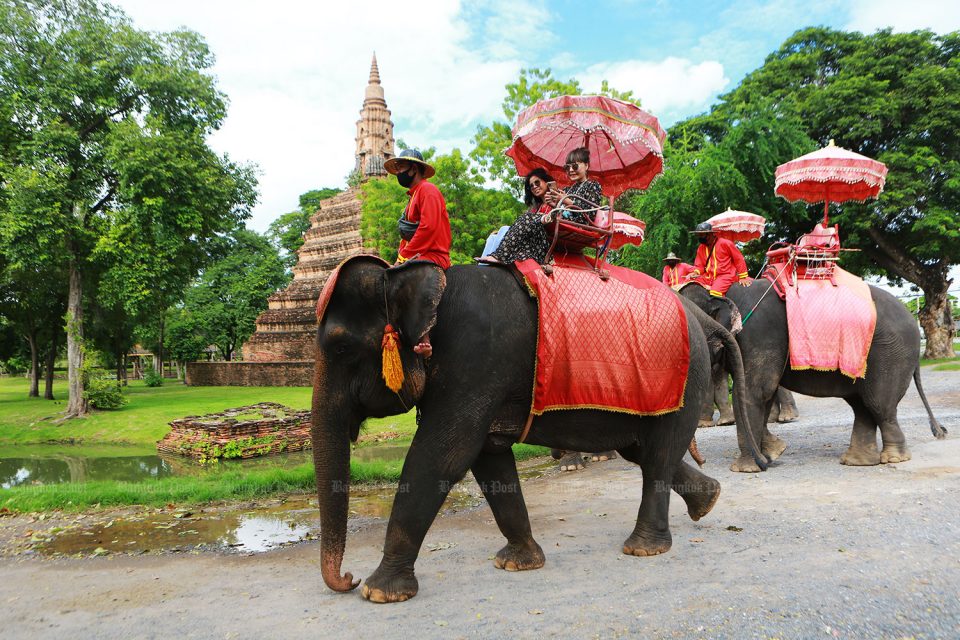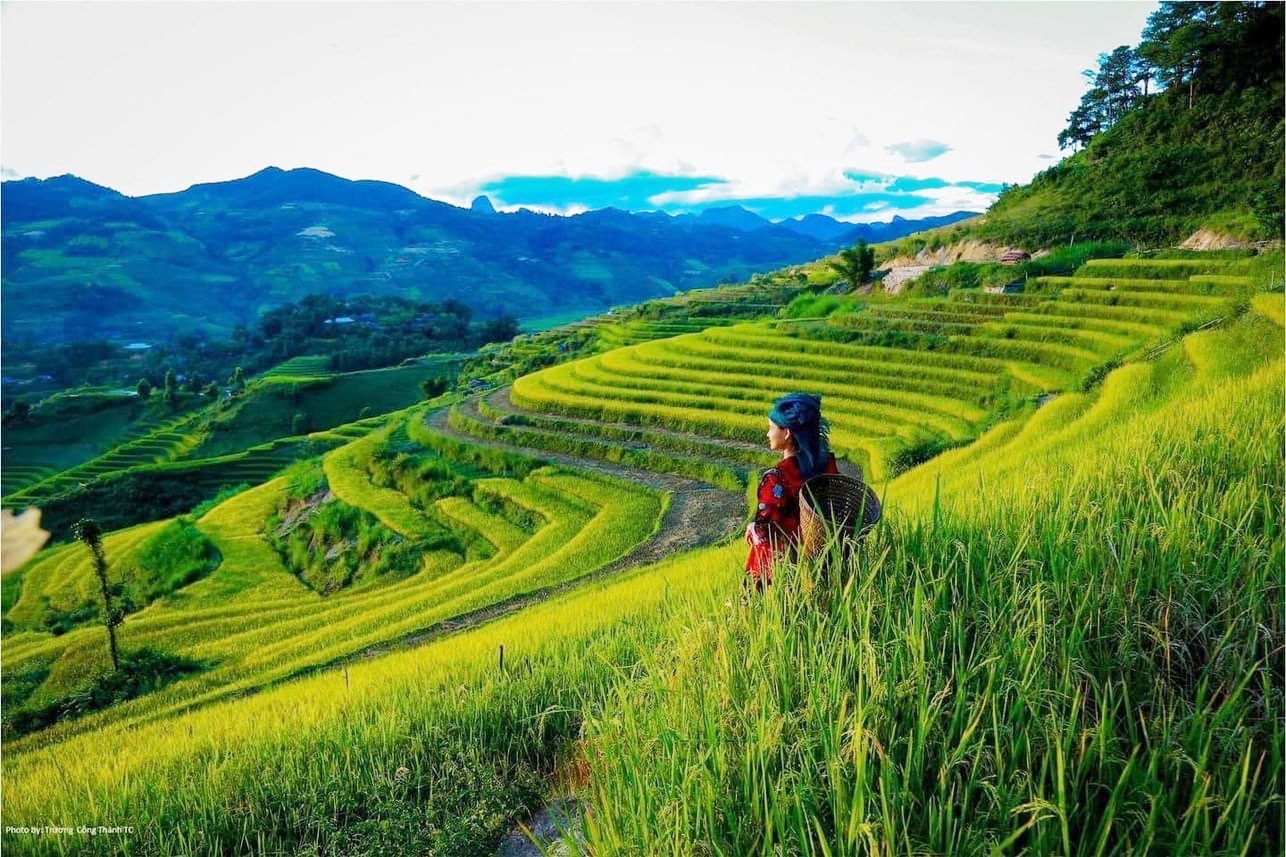Tìm kiếm
Các Tour Mới
TUA CHUA: A NEW DESTINATION TO EXPLORE
TUA CHUA: A NEW DESTINATION TO EXPLORE (An impressive location worth visiting)
Hoang Nam International Travel Company Limited in Dien Bien recommends a memorable destination when you visit Dien Bien, Vietnam:
Hoang Nam International Travel Company Limited in Dien Bien recommends a memorable destination when you visit Dien Bien, Vietnam:
Tua Chua is a rural district located in the northwestern mountainous province of Dien Bien, Vietnam. The district capital is also named Tua Chua. This region is characterized by its stunning natural landscapes, including the Trung Thu pine forest, ancient tea trees in Sin Chai, the Ta Si Lang mountain ebony forests, and the ancient rocky plateau of Ta Phin. Additionally, Tua Chua also features a diverse system of terraced fields and pristine caves, making it an attractive destination for adventure tourism.
In addition to that, Tua Chua is home to seven ethnic groups (Mong 73%), each contributing unique cultural identities and traditions. Local attractions include traditional wet markets in Ta Sin Thang and Xa Nhe communes, which showcase local agricultural products and cultural heritage. The Tua Chua night market has emerged as a popular tourist destination where visitors can experience local cuisine and art performances while engaging with local sellers who utilize live streaming for sales.
Despite its potential, tourism development in Tua Chua faces several challenges. Its remote location makes it difficult to access from the provincial center, and the absence of a national highway passing through the area compounds this issue. Furthermore, many tourist sites lack cohesive investment and professional services, which limits visitor engagement and shortens their stays.
In future Prospects:
Local government officials are committed to sustainable tourism practices aimed at creating an inviting environment for external investments while enhancing local infrastructure and services. This commitment includes promoting unique cultural experiences such as those found at the night market alongside natural attractions like caves and terraced fields.
The vision for Tua Chua includes transforming it into a key economic sector within Dien Bien province through strategic planning focused on leveraging its natural beauty and cultural richness.
Some recommended places to visit include:
1. The ancient rocky plateau of Ta Phin
In addition to that, Tua Chua is home to seven ethnic groups (Mong 73%), each contributing unique cultural identities and traditions. Local attractions include traditional wet markets in Ta Sin Thang and Xa Nhe communes, which showcase local agricultural products and cultural heritage. The Tua Chua night market has emerged as a popular tourist destination where visitors can experience local cuisine and art performances while engaging with local sellers who utilize live streaming for sales.
Despite its potential, tourism development in Tua Chua faces several challenges. Its remote location makes it difficult to access from the provincial center, and the absence of a national highway passing through the area compounds this issue. Furthermore, many tourist sites lack cohesive investment and professional services, which limits visitor engagement and shortens their stays.
In future Prospects:
Local government officials are committed to sustainable tourism practices aimed at creating an inviting environment for external investments while enhancing local infrastructure and services. This commitment includes promoting unique cultural experiences such as those found at the night market alongside natural attractions like caves and terraced fields.
The vision for Tua Chua includes transforming it into a key economic sector within Dien Bien province through strategic planning focused on leveraging its natural beauty and cultural richness.
Some recommended places to visit include:
1. The ancient rocky plateau of Ta Phin
.jpg)
Located 10 km from the town center, the ancient rocky plateau of Ta Phin is a significant geographical and cultural feature in the Tủa Chùa District of the northwestern mountainous province of Dien Bien. This plateau is characterized by its unique cat-ear-shaped Rocky Mountains, which cover over 70% of the land in the area. The harsh natural environment poses numerous challenges for agricultural production due to the limited arable land and difficult terrain.
The natural beauty and unique geological features attract visitors who are interested in exploring this rugged landscape. The region’s cultural heritage, including traditional practices and lifestyles of various ethnic groups residing in Ta Phin, further enhances its appeal as a tourist destination.
The residents of Ta Phin have demonstrated remarkable resilience and ingenuity in adapting to their environment. They have developed methods to cultivate food crops on this rocky landscape. During the rainy season, farmers engage in labor-intensive practices such as carrying soil into rock crevices and arranging stones around crops to prevent soil erosion. This persistent effort has transformed parts of the plateau into green corn fields, symbolizing the vitality and determination of the local people.
The combination of stunning natural landscapes and rich cultural experiences positions Ta Phin as an emerging site for adventure tourism and exploration activities.
The ancient rocky plateau of Ta Phin serves not only as a challenging environment for its inhabitants but also as a canvas for showcasing human resilience and cultural richness amidst adversity.
2. Terraced rice fields
The significant feature of the region’s agricultural landscape is its terraced fields. These fields are not only vital for local agriculture but also contribute to the area’s tourism potential due to their stunning visual appeal and cultural significance. Moreover, the picturesque landscape of terraced rice fields in Tua Chua is comparable to other famous regions in Northwest Vietnam that attract tourists seeking natural beauty and authentic cultural experiences.
Terrace rice fields are an ancient agricultural practice that allows farmers to cultivate rice on steep slopes. This method helps prevent soil erosion and maximizes arable land in hilly terrains. In Tua Chua, these terraces are meticulously constructed and maintained by local farmers, showcasing their traditional farming techniques and deep connection to the land. The cultivation of rice in these terraces is essential for food security and sustains the livelihoods of many families within the district.
The significance of these sites extends beyond agriculture; they hold cultural importance for the seven ethnic groups residing in Tua Chua. Each group has its own unique traditions and practices related to rice cultivation, which are often celebrated through festivals and community events. The fields serve as a backdrop for these cultural expressions, making them an integral part of the local identity.
.jpg)
The natural beauty and unique geological features attract visitors who are interested in exploring this rugged landscape. The region’s cultural heritage, including traditional practices and lifestyles of various ethnic groups residing in Ta Phin, further enhances its appeal as a tourist destination.
The residents of Ta Phin have demonstrated remarkable resilience and ingenuity in adapting to their environment. They have developed methods to cultivate food crops on this rocky landscape. During the rainy season, farmers engage in labor-intensive practices such as carrying soil into rock crevices and arranging stones around crops to prevent soil erosion. This persistent effort has transformed parts of the plateau into green corn fields, symbolizing the vitality and determination of the local people.
The combination of stunning natural landscapes and rich cultural experiences positions Ta Phin as an emerging site for adventure tourism and exploration activities.
The ancient rocky plateau of Ta Phin serves not only as a challenging environment for its inhabitants but also as a canvas for showcasing human resilience and cultural richness amidst adversity.
2. Terraced rice fields
The significant feature of the region’s agricultural landscape is its terraced fields. These fields are not only vital for local agriculture but also contribute to the area’s tourism potential due to their stunning visual appeal and cultural significance. Moreover, the picturesque landscape of terraced rice fields in Tua Chua is comparable to other famous regions in Northwest Vietnam that attract tourists seeking natural beauty and authentic cultural experiences.
Terrace rice fields are an ancient agricultural practice that allows farmers to cultivate rice on steep slopes. This method helps prevent soil erosion and maximizes arable land in hilly terrains. In Tua Chua, these terraces are meticulously constructed and maintained by local farmers, showcasing their traditional farming techniques and deep connection to the land. The cultivation of rice in these terraces is essential for food security and sustains the livelihoods of many families within the district.
The significance of these sites extends beyond agriculture; they hold cultural importance for the seven ethnic groups residing in Tua Chua. Each group has its own unique traditions and practices related to rice cultivation, which are often celebrated through festivals and community events. The fields serve as a backdrop for these cultural expressions, making them an integral part of the local identity.
.jpg)
3. Windy Pass
Located in one part of Tua Chua, the road leads to two communes: Trung Thu and Ta Sin Thang. The pass features a winding, narrow path with steep drops into the Nam Muc River on one side and towering cliffs on the other, providing spectacular vistas at every turn. The road runs along rocky mountainsides.
Windy Pass was named by local people because it resembles the name and has similar dangers as one of the passes in Ha Giang Province. It is renowned for its stunning mountains that offer breathtaking views, providing thrilling experiences for motorbike riders. Additionally, it showcases stunning vistas of limestone karsts and is a popular stop for those looking to capture photographs of the dramatic sunset landscape.
Located in one part of Tua Chua, the road leads to two communes: Trung Thu and Ta Sin Thang. The pass features a winding, narrow path with steep drops into the Nam Muc River on one side and towering cliffs on the other, providing spectacular vistas at every turn. The road runs along rocky mountainsides.
Windy Pass was named by local people because it resembles the name and has similar dangers as one of the passes in Ha Giang Province. It is renowned for its stunning mountains that offer breathtaking views, providing thrilling experiences for motorbike riders. Additionally, it showcases stunning vistas of limestone karsts and is a popular stop for those looking to capture photographs of the dramatic sunset landscape.
4. The ancient tea trees in Sin Chai
The ancient tea trees located in Sin Chai commune, approximately 40 km from the town center, represent a significant cultural and agricultural asset. This area is home to nearly 4,000 ancient Shan Tuyet tea trees, which lie among the two villages of the Mong minority and are renowned for their exceptional quality and unique flavor profile. These trees are classified as “ancient” because they are 100 years old or more, with many being several hundred years old.
The cultivation of these ancient tea trees does not require pesticides or extensive care due to their natural growth conditions. They thrive at high altitudes (around 1,800 meters above sea level) in a climate characterized by cool temperatures and frequent cloud cover. Local ethnic communities have traditionally harvested tea buds from these trees manually. For instance, villagers climb the tall trees (which can reach heights of 4 to 10 meters) to pick young buds during specific times of the day, often in the early morning and avoiding rainy days.
Shan Tuyet tea is particularly noted for its clean taste and aromatic qualities. When brewed, it produces a golden-green liquid with a unique flavor that starts slightly bitter but leaves a sweet aftertaste. The local people have developed traditional methods for harvesting and processing this tea over generations, contributing to its cultural significance within the community.
Visiting these villages during the tea harvesting season offers tourists a golden opportunity to take photographs and join the locals in experiencing the process firsthand.
The ancient tea trees located in Sin Chai commune, approximately 40 km from the town center, represent a significant cultural and agricultural asset. This area is home to nearly 4,000 ancient Shan Tuyet tea trees, which lie among the two villages of the Mong minority and are renowned for their exceptional quality and unique flavor profile. These trees are classified as “ancient” because they are 100 years old or more, with many being several hundred years old.
The cultivation of these ancient tea trees does not require pesticides or extensive care due to their natural growth conditions. They thrive at high altitudes (around 1,800 meters above sea level) in a climate characterized by cool temperatures and frequent cloud cover. Local ethnic communities have traditionally harvested tea buds from these trees manually. For instance, villagers climb the tall trees (which can reach heights of 4 to 10 meters) to pick young buds during specific times of the day, often in the early morning and avoiding rainy days.
Shan Tuyet tea is particularly noted for its clean taste and aromatic qualities. When brewed, it produces a golden-green liquid with a unique flavor that starts slightly bitter but leaves a sweet aftertaste. The local people have developed traditional methods for harvesting and processing this tea over generations, contributing to its cultural significance within the community.
Visiting these villages during the tea harvesting season offers tourists a golden opportunity to take photographs and join the locals in experiencing the process firsthand.
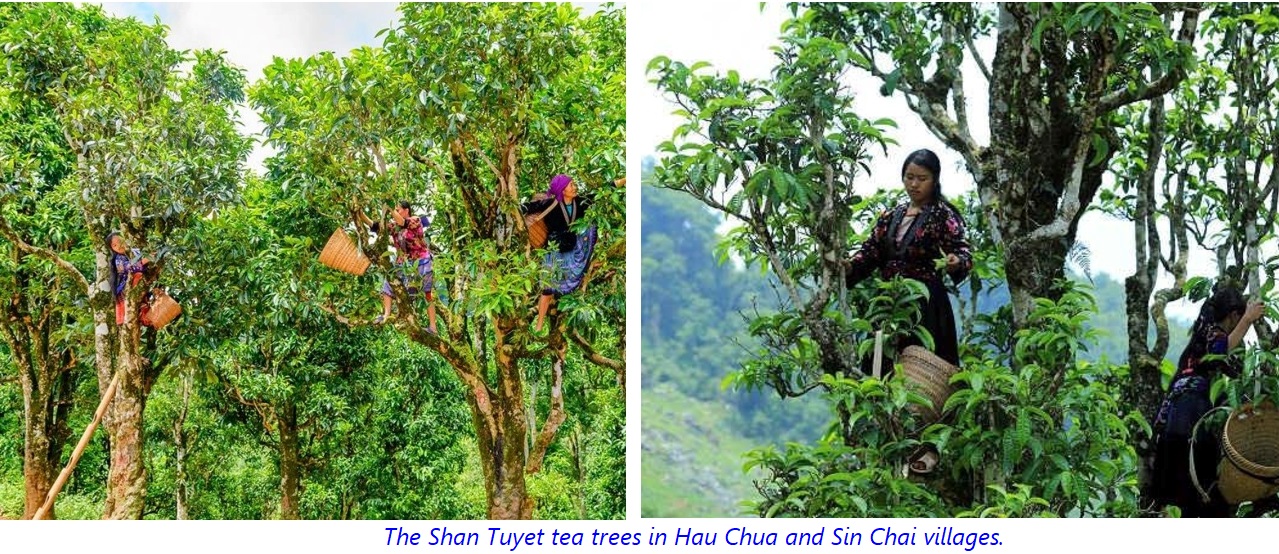
5. The pine forest in Trung Thu
The Trung Thu pine forest is a significant natural feature located in the Tua Chua highland district of Dien Bien Province. This pine forest represents an important ecological asset with significant potential for tourism development while also holding cultural importance for local communities.
The pine forest plays a crucial role in maintaining the local ecosystem. Pine trees are known for their ability to thrive in mountainous terrains and poor soil conditions, making them well-suited for the highland areas of Tua Chua. These trees help prevent soil erosion and maintain water quality by stabilizing the soil with their root systems.
This area has been identified as a prime location for adventure and exploration activities. Its stunning natural landscapes offer opportunities for hiking, photography, and nature walks. The serene environment attracts visitors seeking tranquility and an escape from urban life.
In addition to its ecological and tourism value, the pine forest holds cultural significance for local ethnic communities. The presence of these forests often intertwines with local traditions and practices, providing resources such as timber and non-timber forest products that support livelihoods. The cultural identity of the ethnic groups residing in Tua Chua is closely linked to their relationship with nature, including the pine forests.
The Trung Thu pine forest is a significant natural feature located in the Tua Chua highland district of Dien Bien Province. This pine forest represents an important ecological asset with significant potential for tourism development while also holding cultural importance for local communities.
The pine forest plays a crucial role in maintaining the local ecosystem. Pine trees are known for their ability to thrive in mountainous terrains and poor soil conditions, making them well-suited for the highland areas of Tua Chua. These trees help prevent soil erosion and maintain water quality by stabilizing the soil with their root systems.
This area has been identified as a prime location for adventure and exploration activities. Its stunning natural landscapes offer opportunities for hiking, photography, and nature walks. The serene environment attracts visitors seeking tranquility and an escape from urban life.
In addition to its ecological and tourism value, the pine forest holds cultural significance for local ethnic communities. The presence of these forests often intertwines with local traditions and practices, providing resources such as timber and non-timber forest products that support livelihoods. The cultural identity of the ethnic groups residing in Tua Chua is closely linked to their relationship with nature, including the pine forests.
.png)
The Po Chua Lu pine forest offers a stunning view at sunrise.
6. Huoi So Bay
Huoi So is known as the most remote commune within Tua Chua District, characterized by its challenging geographical conditions and high poverty rates among its residents. The area is located near the Da River, which plays a crucial role in the local economy and culture.
The population primarily consists of ethnic groups such as the Dao and Mong. This community has preserved unique cultural practices, including weaving, traditional clothing, customs, and rituals.
Despite being remote, recent efforts have focused on transitioning agricultural practices from subsistence farming to more sustainable methods, such as terraced rice cultivation and aquaculture. The local government has implemented projects to enhance transportation infrastructure, enabling better access to markets and resources.
The natural beauty of Huoi So Bay, particularly the Pa Phong Bridge, which spans across the bay, offers a picturesque view of the green forests and the reservoir's waters. This serene environment creates a significant vista, evoking unforgettable memories for tourists who wish to return one day.
Along with its cultural richness, the area presents opportunities for tourism development. Scenic landscapes along the Da Giang River can attract visitors interested in eco-tourism and cultural experiences. Local homestays have begun to emerge, providing accommodations for tourists while promoting local traditions and cuisine.
Huoi So is known as the most remote commune within Tua Chua District, characterized by its challenging geographical conditions and high poverty rates among its residents. The area is located near the Da River, which plays a crucial role in the local economy and culture.
The population primarily consists of ethnic groups such as the Dao and Mong. This community has preserved unique cultural practices, including weaving, traditional clothing, customs, and rituals.
Despite being remote, recent efforts have focused on transitioning agricultural practices from subsistence farming to more sustainable methods, such as terraced rice cultivation and aquaculture. The local government has implemented projects to enhance transportation infrastructure, enabling better access to markets and resources.
The natural beauty of Huoi So Bay, particularly the Pa Phong Bridge, which spans across the bay, offers a picturesque view of the green forests and the reservoir's waters. This serene environment creates a significant vista, evoking unforgettable memories for tourists who wish to return one day.
Along with its cultural richness, the area presents opportunities for tourism development. Scenic landscapes along the Da Giang River can attract visitors interested in eco-tourism and cultural experiences. Local homestays have begun to emerge, providing accommodations for tourists while promoting local traditions and cuisine.
.jpg)
A great view from above down to the Huoi So Bay.
7. Kho Chua La cave
Kho Chua La Cave is located 15 kilometers from the center of Tua Chua District, a remarkable natural formation in Dien Bien Province. Discovered by local inhabitants in 2008, this cave is situated approximately 1,000 meters above sea level and has a depth exceeding 800 meters. The cave is divided into three distinct compartments, each showcasing unique geological features and stunning stalactites.
Its entrance is small and deep, oriented towards the southeast. To access the cave, visitors must climb 180 steps from a nearby parking area. Inside the cave, temperatures consistently range between 20 to 21 degrees Celsius, providing a cool respite for visitors exploring its depths. The enchanting beauty of the stalactites takes on various forms; some resemble animals, such as elephants or dragons, creating a magical atmosphere throughout the cave.
Exploring Kho Chua La Cave offers an unforgettable experience that highlights both its natural beauty and historical significance within Vietnam’s landscape.
Kho Chua La Cave is located 15 kilometers from the center of Tua Chua District, a remarkable natural formation in Dien Bien Province. Discovered by local inhabitants in 2008, this cave is situated approximately 1,000 meters above sea level and has a depth exceeding 800 meters. The cave is divided into three distinct compartments, each showcasing unique geological features and stunning stalactites.
Its entrance is small and deep, oriented towards the southeast. To access the cave, visitors must climb 180 steps from a nearby parking area. Inside the cave, temperatures consistently range between 20 to 21 degrees Celsius, providing a cool respite for visitors exploring its depths. The enchanting beauty of the stalactites takes on various forms; some resemble animals, such as elephants or dragons, creating a magical atmosphere throughout the cave.
Exploring Kho Chua La Cave offers an unforgettable experience that highlights both its natural beauty and historical significance within Vietnam’s landscape.
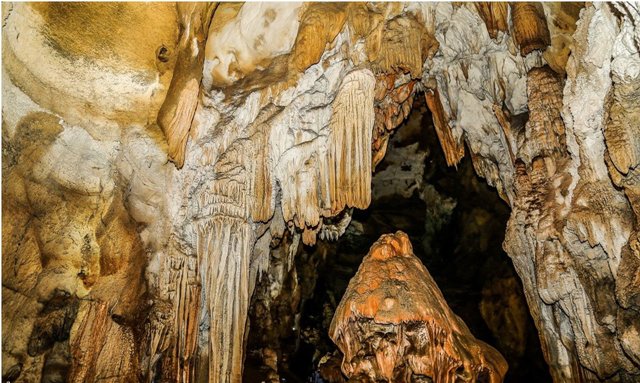
8. The traditional ethnic market
The traditional ethnic market in Tua Chua is a vibrant gathering place that operates on market days. It serves as a crucial meeting venue for various ethnic groups, including the Mong, Thai, Xa Phang, and Dao people. The market showcases the rich agricultural products and unique cultural heritage of the region, primarily featuring goods from the Mong people, who are the majority. It highlights the opportunity to shop for diverse products while interacting with friendly local residents.
Visitors to the market can experience the unique specialties of Tua Chua District. The market not only offers a variety of goods but also serves as a cultural hub where individuals can learn about the local customs, traditions, and lifestyles of the various ethnic groups present.
The night market, which falls on Saturday nights, has become not just a place for commerce but also a social event that strengthens community ties. It also offers a variety of traditional dishes, such as thang co (a dish made from horse meat and offal) and Mong Pe (an aromatic wine made from maize).
Overall, the traditional ethnic market in Tua Chua plays a vital role as a cultural and economic hub for local ethnic communities, facilitating trade and fostering social interactions among participants.
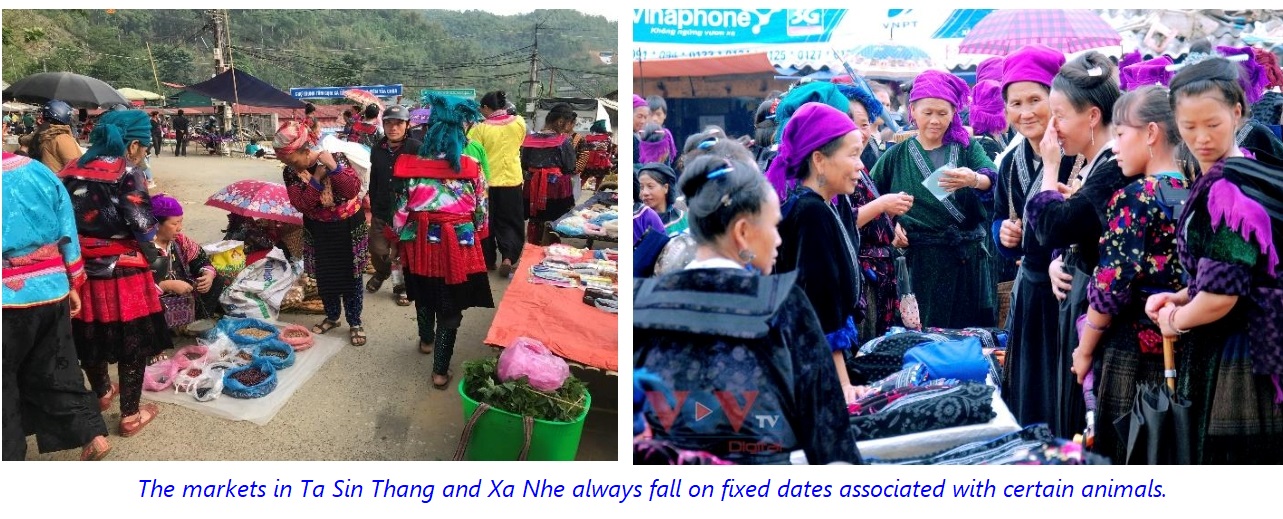
---------------------------
𝗛𝗼𝗮𝗻𝗴 𝗡𝗮𝗺 𝗜𝗻𝘁𝗲𝗿𝗻𝗮𝘁𝗶𝗼𝗻𝗮𝗹 𝗧𝗿𝗮𝘃𝗲𝗹 𝗖𝗼𝗺𝗽𝗮𝗻𝘆, 𝘄𝗵𝗶𝗰𝗵 𝗼𝗽𝗲𝗿𝗮𝘁𝗲𝘀 𝗶𝗻 𝗗𝗶𝗲𝗻 𝗕𝗶𝗲𝗻 𝗣𝗵𝘂 𝗖𝗶𝘁𝘆, 𝗰𝗮𝗻 𝗮𝘀𝘀𝗶𝘀𝘁 𝘆𝗼𝘂 𝘄𝗶𝘁𝗵 𝗲𝘃𝗲𝗿𝘆𝘁𝗵𝗶𝗻𝗴 𝗱𝘂𝗿𝗶𝗻𝗴 𝘆𝗼𝘂𝗿 𝘃𝗶𝘀𝗶𝘁 𝘁𝗼 𝗗𝗶𝗲𝗻 𝗕𝗶𝗲𝗻 𝗣𝗿𝗼𝘃𝗶𝗻𝗰𝗲.
28 Sep, 2024 - By Do Ngoc Hoan
BÀI VIẾT CÙNG CHỦ ĐỀ



.jpg)
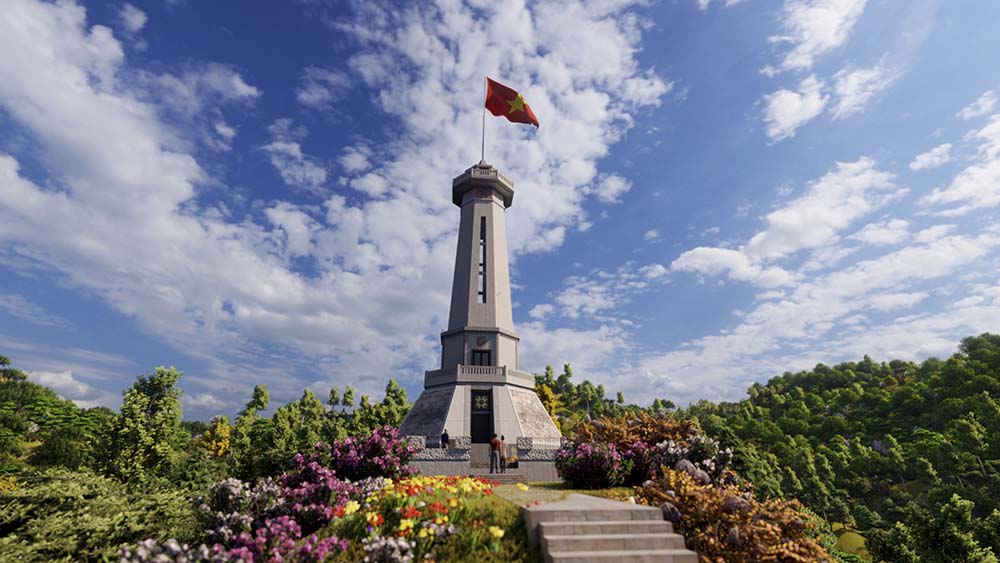
.jpg)

